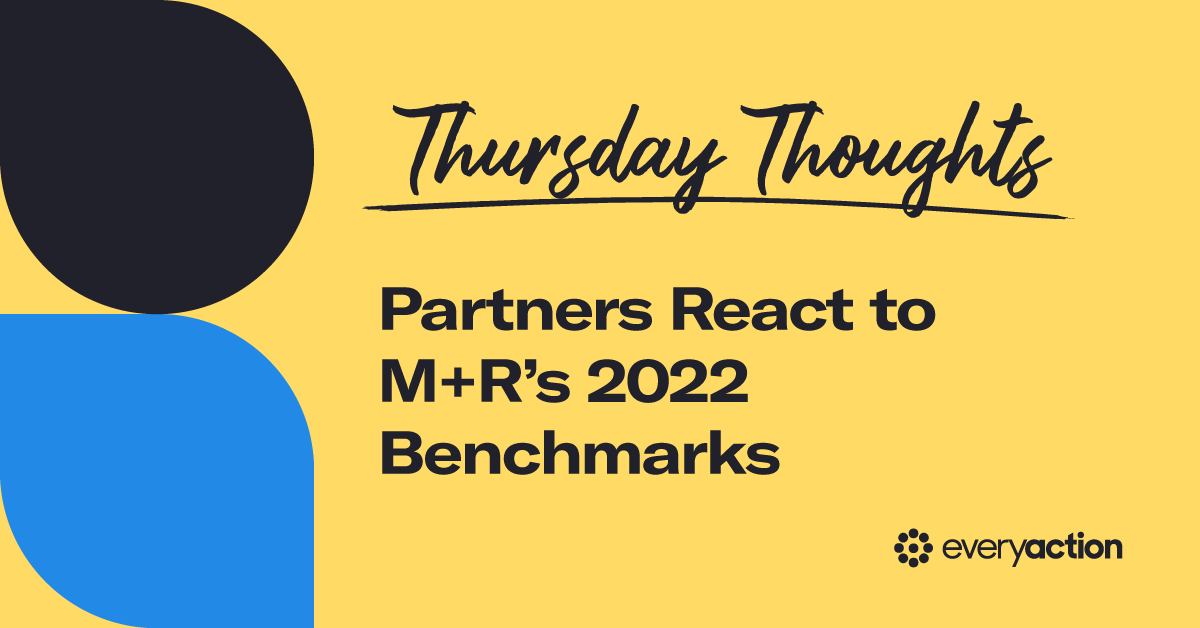Thursday Thoughts | Partners React to the M+R 2022 Benchmarks

Welcome to another installment of Thursday Thoughts, a dedicated space for our friends in nonprofit sector leadership to reflect on reports, statistics, and other trends—because when our community shares knowledge, we can all do more good. Check out last month’s post here!
Every year, M+R releases a set of Benchmarks to help nonprofits track and understand trends in supporter messaging, fundraising, and engagement techniques. We asked our partners, what’s one finding that surprises or attracts your attention the most about this year’s report? What could that finding mean for nonprofits everywhere? Here’s what our friends at Community Boost and Rubenstein Impact Group said.
Community Boost
To us, some of this year’s most eye-catching findings were the stats on nonprofit digital ad performance. All nonprofits, especially those who have a smaller budget, are pressed to find the best channel or avenue where they will see the highest return on ad spend (ROAS,) so it’s important to make the most of every dollar.
The M+R Benchmark report shows that search has the highest ROAS ($3.72)—which presents nonprofits with additional incentives to take full advantage of the free $10,000-per-month Google Ad Grant for awareness and fundraising. Investing time into maximizing ad spend now can help nonprofits set themselves up for growth.
To that point, the Nonprofit Acceleration Report found that only 21 percent of nonprofits were “very likely” to use paid digital ads like paid search, display, and video. Therefore, nonprofits that want to drive the most growth now can invest in running Google Ads with their grant, as well as investing in paid search to get ahead of trends and maximize their results.
Additionally, since the ROAS is low for display ads ($0.16), it’s time to look at the potential effectiveness of nonprofit YouTube and display ads and learn how to optimize them for a higher return since this channel has the opportunity to be leveraged further to help medium-to-large organizations stay ahead of the digital curve. Lastly, nonprofits can take these six action steps now to ensure they’re getting the most out of their ad spend, even in the face of changing privacy regulations across Apple devices and browsers like Google Chrome.
Community Boost is a caring, creative, and committed group of purpose-driven digital marketers, hyper-focused on empowering social ventures changing the world by accelerating and scaling online revenue and impact. Learn more here.
Brian Rubenstein, Rubenstein Impact Group
I was disappointed to see in the latest edition of M+R’s Benchmarks that clickthrough rates for advocacy emails were down 9.2 percent. If the age of hyper-activism that was ignited after the 2016 election and then re-ignited after George Floyd’s death is subsiding, it will become even more important for organizations to focus on writing email content that is highly relevant to their audience (not just the organization) and focuses on the human impact of the legislation they’re asking volunteers to take action on.
Any organizations seeing such a drop should definitely be A/B testing their subject lines, email content and asks, as well as taking a closer look at their segmentation. Techniques like these will help them learn the most effective ways to communicate with their audience, especially in the face of changing open rates due in part to Apple’s email privacy update. When done well, these practices can help reverse the downturns in clickthrough rates that nonprofits are experiencing.


